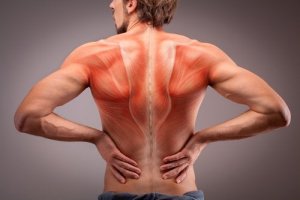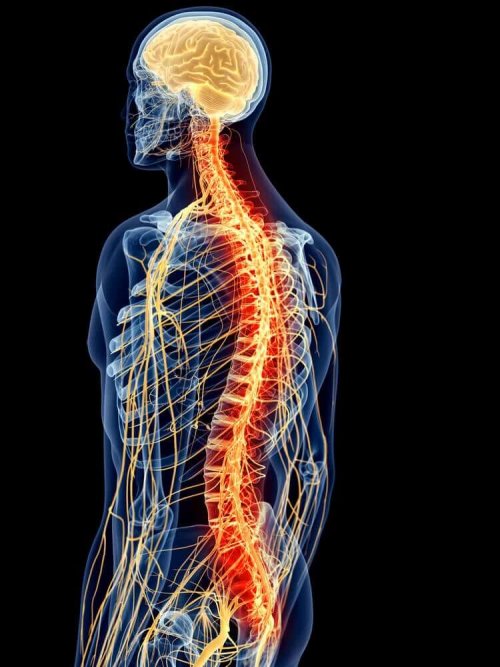The Anatomy of the Back Muscles


Written and verified by the doctor Leonardo Biolatto
The anatomy of the back is interesting, especially when it comes to the muscles in the back region of the body between the shoulders. In this article, we’ll take a look at some of the most important muscles in the back and what they do.
The back
Overall, we can divide the back into two regions:
- Thoracic area: This is the upper part of the back that connects to the upper limbs and thoracic organs, such as the lungs and the heart.
- Lumbar area: This is the lower part of the back, below the chest, that’s linked to the lumbar spine and abdominal organs, such as the liver and intestines.
The anatomy of the back muscles basically defines their functions according to the location they occupy in the human body and to the other structures with which they connect. These muscles determine body posture and also regulate the three basic movements of the trunk: flexion, rotation, and extension. They’re a common object of study in the field of occupational medicine due to common workplace injuries.
The back muscles contribute to the protection of the organs of the thorax and abdomen, forming part of the walls that isolate them from the outside. Some of these muscles, usually the smallest ones, are also part of the mechanism of mobilization of the upper limbs.
We won’t describe all the back muscles in this article, but we’ll see an overview of the most relevant. Thus, we’ll divide them into three regions, according to their depth. So, let’s see what the deep, intermediate, and superficial muscles are about.
The anatomy of the back muscles: The deep plane
These are the muscles that are farther from the surface, closer to the internal organs and the spine. As a general group, they extend from the neck to the sacrum and fulfill a basic and fundamental function: to control the posture of the entire body.
Let’s see some:
- Spinal: These run along the entire spine, between the spinous processes and the transverse processes of the vertebrae. Scientific studies in recent years have discovered how bad job positions are poorly affecting them. There are two types:
- The interspinous ligament binds the spinous processes of different vertebrae; it’s a spinal extender.
- The intertransverse ligament does the same with the transverse processes; it’s in charge of lateral movements.
- Sacrolumbar ligaments: These join the pelvis with the spine and reach some cervical vertebrae. They can extend the spine and also play a very important role in tilting the trunk to the sides.
- Dorsal Serratos: These come in two varieties: the cranial Serrato or posterosuperior Serrato and the caudal or posteroinferior Serrato. They participate in respiratory dynamics and help the thorax to inhale and exhale. Also, they originate in the spine and are inserted into the ribs.
You may be interested: The relationship between the spine and the organs
Middle back muscles

We can summarize the function of this muscle group as those regulating the movements of the scapula. They are, therefore, directly linked with the bone that we know as the shoulder blade. This bone pseudo-articulates with the rib cage, so some refer to it as a “false joint” because it is not typically made up like the other joints. Instead, it’s a bone surface (the scapula) on muscles (the Serratos).
Here, we can find two interesting muscles:
- Angular of the shoulder blade: This is the scapula lift and could also be classified as a muscle of the upper limbs due to the goal it serves. It’s born in the shoulder blade and reaches the cervical vertebrae.
- Rhomboids: When this muscle contracts, it approaches the scapula to the spine in an adduction movement. It also communicates to the shoulder blade with the column in its inserts. It owes its name to the rhombus shape it possesses.
The anatomy of the back muscles: Superficial plane
These are the best known because they’re linked to bodybuilding and aesthetics. Good development of these back muscles generates a characteristic figure in those who exercise regularly.
However, they have an importance that is far from aesthetic in function. The muscles of this plane are actively involved in the movements of the shoulder joint.

Find out more: Find Out How to Stretch Your Spine in Just 2 Minutes
These are the two most relevant:
- Trapezium: This is one of the largest muscles and has three parts that connect. It connects to the occipital bone of the skull, the cervical vertebrae, the clavicle, the vertebrae dorsals, and the scapula. They have several functions:
- Shoulder abduction
- The advance of the scapula to the spine
- The descent of the shoulder blade
- Wide dorsal: This one begins its journey in the last dorsal vertebrae and in the part of the body that forms the last three ribs. It’s thin, practically flat, and triangular in shape. When the arm acts as a fixed point, it lifts the trunk.
We hope you enjoyed learning a little more about your body and muscles!
All cited sources were thoroughly reviewed by our team to ensure their quality, reliability, currency, and validity. The bibliography of this article was considered reliable and of academic or scientific accuracy.
- Sobotta, Johannes. Atlas de anatomia humana. Vol. 2. Ed. Médica Panamericana, 2006.
- Norris, Christopher M. La estabilidad de la espalda. Editorial HISPANO EUROPEA, 2007.
- Moore, Keith L., and Arthur F. Dalley. Anatomía con orientación clínica. Ed. Médica Panamericana, 2009.
- Cassan, Adolf. Atlas de anatomía. Grupo Editorial Norma, 2003.
This text is provided for informational purposes only and does not replace consultation with a professional. If in doubt, consult your specialist.








